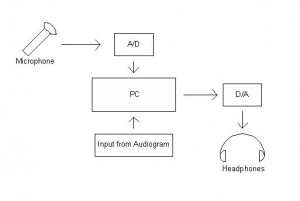Designers: Jason Edwards
INTRODUCTION:
The hearing loss simulator is a computer program that modifies a sound clip based on a child’s audiogram. The therapist enters the audiogram data into the program, characterizing the child’s hearing loss. The program then records, modifies and replays a voice or a music clip as the child would hear it.
SUMMARY OF IMPACT:
This program will provide a means by which parents of a child with hearing loss can understand what their child is capable of hearing. It demonstrates the severity of hearing loss through the comparison of the original sound clip with a sound clip based on the child’s audiogram. This program will help the audiologist and parents have realistic expectations of the child’s future performance. Additionally, the program will aid in the formation of individualized education plans through providing a more accurate representation of hearing loss. Currently, hearing loss is classified as profound, severe, moderate and mild. Most individuals have difficulty in applying these generalized terms to what a child can hear. Current audio examples of hearing loss are not specific to the child and may give only a approximate idea of the type of sounds that a child is able to hear. This program gives a more exact, personal replication of the child’s audio environment.
TECHNICAL DESCRIPTION:
The Hearing Loss Simulator consists of five primary components: a microphone, a PC, a sound card, a software program, and a speaker system.

Fig. 2: Hardware used to implement Hearing Loss Simulator. Audio is recorded via a microphone and converter into a digital form. Data from an audiogram is entered into the PC. The digital signal is modified, then converted back into an analog signal, which is then played through a pair of speakers.
The audiologist must first enter data from the child’s audiogram into the simulator. A polynomial function is matched to the data points, then used to apply the appropriate attenuation at selected frequencies to the recorded audio signal. The PC receives input from the microphone via the sound card. Contained within the sound card is an analog to digital converter that transforms information from the microphone into a form usable by a software program on the PC. Based upon information taken from a patient’s audiogram, the program processes the recorded audio. This altered digital signal is then transformed back into analog format by a digital to analog converter housed on the sound card and ultimately played by a speaker.
The programming is done using Visual Basic 6 and requires a computer running windows 9x or NT at 266MHz or higher. In order to hear the modified sound clip, a 16-bit A/D sound card, a microphone, and speakers are needed.
Initial testing of the simulator has proven that it is qualitatively accurate. Several simple scenarios, such as filtering all high frequencies or all low frequencies, have generated the expected results. The initial impression by people in the audiology field is very optimistic. Although further testing is needed to prove that the simulator is quantitatively accurate and clinically useful, the outlook is promising. The current limitations of the device are that only up to seven data points may be entered from an audiogram and that audio must be recorded and modified before being played back. One major possible enhancement might be to allow the audio to be modified and played as it is being sampled, thus allowing for a real-time system. As it stands, the Hearing Loss Simulator appears that it could prove to be very beneficial in communicating the level of hearing loss in a child to a parent.
Total Cost of this project: $505




One Comment
Is the hearing loss simulation program available for public use. I visit a number of senior centers and would like to have someway of processing a sound clip using their audiogram so I could then hear what they are hearing.
Thanks
Charles Davis